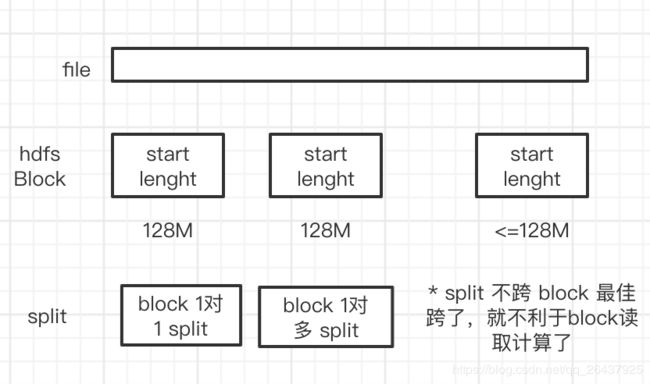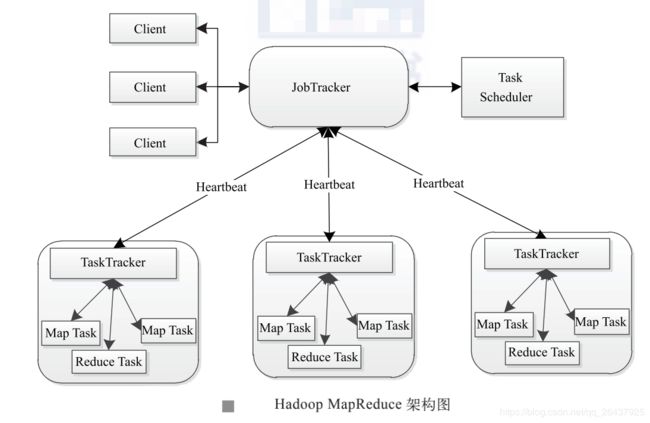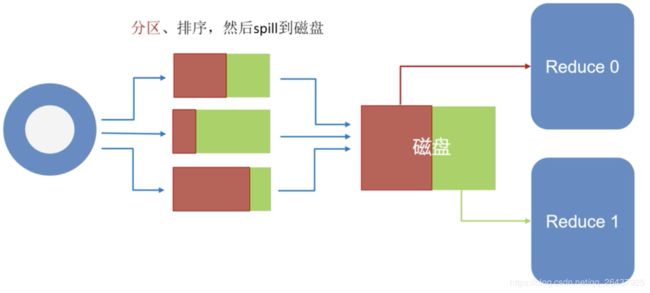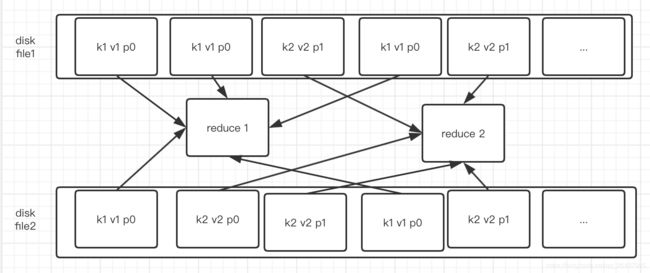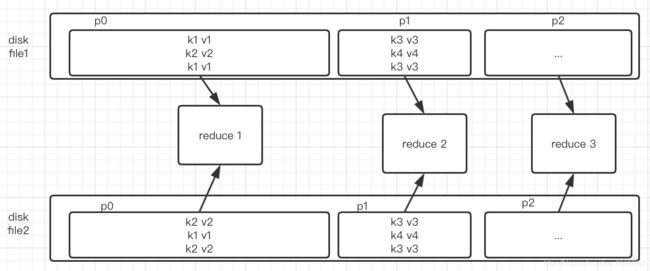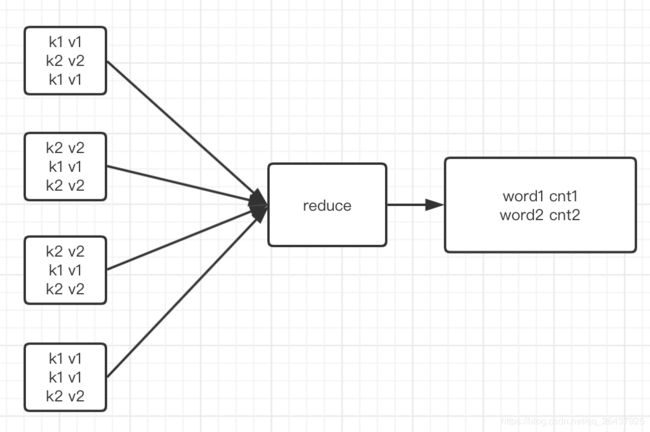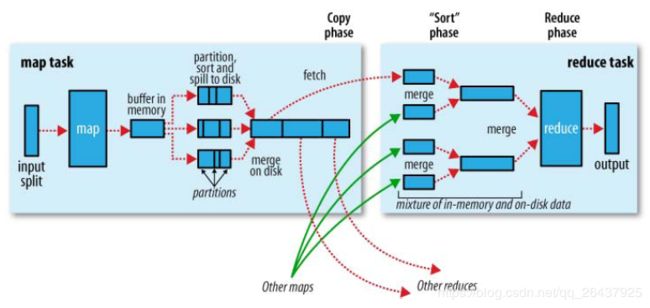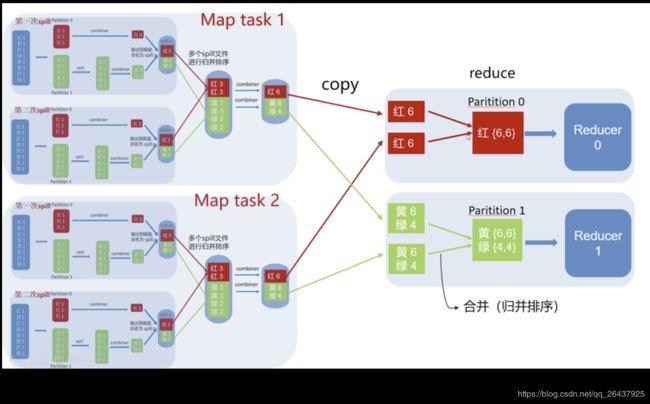hadoop 简单的MapReduce源码分析(源码&流程&word count日志)
目录
- Job提交
- mapTask的输入:splits
- MapReduce Job执行的架构(1.0简单描述)
- MapTask run
- MapTask的`run`方法和流程
- split怎么读取?
- TextInputFormat & LineRecordReader
- 原始 k,v 进行 map 处理
- map结果怎么输出?
- output(org.apache.hadoop.mapreduce.RecordWriter)构造
- 分区(partitioner & 默认的HashPartitioner)
- context.write(collector.collect)
- collect(kv缓冲区) & partition(分区)处理图
- SpillThread(将缓冲区中的数据spill到磁盘)
- flush & mergeParts()
- spill(combiner)到输出文件图
- 回顾MapTask的流程
- 回顾 为什么要排序和分区
- partitions 归并排序
- 在partitions排序的基础上:key再排序
- 为什么有 combiner
- 为什么有 compression
- mapreduce处理流程图
- map 到 shuffle 到 reduce 实例流程图
- ReduceTask
- reduceTask流程
- ReduceTask run()
- reduce的三个阶段
- reduce的输入来源?(shuffle拉取)
- Shuffle run方法
- rIter 迭代器模式的使用?
- runNewReducer
- 如何执行reduce方法?
- shuffle
- mapreduce log 学习
- 输入 & 输出
- 不实用combiner & 使用combiner的log 区别
- 自定义key排序:`job.setSortComparatorClass`
- word count java 程序
上一篇简单的博文写了个最简单的mapreduce程序(https://blog.csdn.net/qq_26437925/article/details/78458471)
,本文则主要是对源码跳转分析Job,MapReduce的过程,对源码有一定的认识和深入
Job提交
/**
* Internal method for submitting jobs to the system.
*
* The job submission process involves:
*
* -
* Checking the input and output specifications of the job.
*
* -
* Computing the {@link InputSplit}s for the job.
*
* -
* Setup the requisite accounting information for the
* {@link DistributedCache} of the job, if necessary.
*
* -
* Copying the job's jar and configuration to the map-reduce system
* directory on the distributed file-system.
*
* -
* Submitting the job to the
JobTracker and optionally
* monitoring it's status.
*
*
* @param job the configuration to submit
* @param cluster the handle to the Cluster
* @throws ClassNotFoundException
* @throws InterruptedException
* @throws IOException
*/
JobStatus submitJobInternal(Job job, Cluster cluster)
// 把任务相关的文件,配置,jars上传
copyAndConfigureFiles(job, submitJobDir);
// 获取配置文件job.xml的路径
Path submitJobFile = JobSubmissionFiles.getJobConfPath(submitJobDir);
// 输入文件的splits,配置信息写入job信息中
// Create the splits for the job
LOG.debug("Creating splits at " + jtFs.makeQualified(submitJobDir));
int maps = writeSplits(job, submitJobDir);
conf.setInt(MRJobConfig.NUM_MAPS, maps);
LOG.info("number of splits:" + maps);
int maxMaps = conf.getInt(MRJobConfig.JOB_MAX_MAP,
MRJobConfig.DEFAULT_JOB_MAX_MAP);
if (maxMaps >= 0 && maxMaps < maps) {
throw new IllegalArgumentException("The number of map tasks " + maps +
" exceeded limit " + maxMaps);
}
// 设置job使用的资源队列
// write "queue admins of the queue to which job is being submitted"
// to job file.
String queue = conf.get(MRJobConfig.QUEUE_NAME,
JobConf.DEFAULT_QUEUE_NAME);
AccessControlList acl = submitClient.getQueueAdmins(queue);
conf.set(toFullPropertyName(queue,
QueueACL.ADMINISTER_JOBS.getAclName()), acl.getAclString());
// removing jobtoken referrals before copying the jobconf to HDFS
// as the tasks don't need this setting, actually they may break
// because of it if present as the referral will point to a
// different job.
TokenCache.cleanUpTokenReferral(conf);
if (conf.getBoolean(
MRJobConfig.JOB_TOKEN_TRACKING_IDS_ENABLED,
MRJobConfig.DEFAULT_JOB_TOKEN_TRACKING_IDS_ENABLED)) {
// Add HDFS tracking ids
ArrayList<String> trackingIds = new ArrayList<String>();
for (Token<? extends TokenIdentifier> t :
job.getCredentials().getAllTokens()) {
trackingIds.add(t.decodeIdentifier().getTrackingId());
}
conf.setStrings(MRJobConfig.JOB_TOKEN_TRACKING_IDS,
trackingIds.toArray(new String[trackingIds.size()]));
}
// Set reservation info if it exists
ReservationId reservationId = job.getReservationId();
if (reservationId != null) {
conf.set(MRJobConfig.RESERVATION_ID, reservationId.toString());
}
// Write job file to submit dir
writeConf(conf, submitJobFile);
// submitClient.submitJob 提交Job
//
// Now, actually submit the job (using the submit name)
//
printTokens(jobId, job.getCredentials());
status = submitClient.submitJob(
jobId, submitJobDir.toString(), job.getCredentials());
if (status != null) {
return status;
} else {
throw new IOException("Could not launch job");
}
} finally {
if (status == null) {
LOG.info("Cleaning up the staging area " + submitJobDir);
if (jtFs != null && submitJobDir != null)
jtFs.delete(submitJobDir, true);
}
}
- 输入文件 writeNewSplits
@SuppressWarnings("unchecked")
private <T extends InputSplit>
int writeNewSplits(JobContext job, Path jobSubmitDir) throws IOException,
InterruptedException, ClassNotFoundException {
Configuration conf = job.getConfiguration();
// 获取输入文件格式,默认:TextInputFormat
InputFormat<?, ?> input =
ReflectionUtils.newInstance(job.getInputFormatClass(), conf);
// 进行split操作
List<InputSplit> splits = input.getSplits(job);
T[] array = (T[]) splits.toArray(new InputSplit[splits.size()]);
// 排序,让最大的split优先处理
// sort the splits into order based on size, so that the biggest
// go first
Arrays.sort(array, new SplitComparator());
// 把split文件信息写入
JobSplitWriter.createSplitFiles(jobSubmitDir, conf,
jobSubmitDir.getFileSystem(conf), array);
return array.length;
}
mapTask的输入:splits
可以通过配置BlockSize、split min size、split max size 等参数,达到控制mapper的数量(注意到:即使在程序里对 conf 显式地设置了 mapred.map.tasks 或 mapreduce.job.maps,程序不一定能运行期望数量的 mapper)
- input.getSplits(job); (org.apache.hadoop.mapreduce.lib.input
FileInputFormat)
/**
* Generate the list of files and make them into FileSplits.
* @param job the job context
* @throws IOException
*/
public List<InputSplit> getSplits(JobContext job) throws IOException {
StopWatch sw = new StopWatch().start();
// split的最大最小值,可配置
long minSize = Math.max(getFormatMinSplitSize(), getMinSplitSize(job));
long maxSize = getMaxSplitSize(job);
// 获取job信息,并判断产生split
// generate splits
List<InputSplit> splits = new ArrayList<InputSplit>();
List<FileStatus> files = listStatus(job);
boolean ignoreDirs = !getInputDirRecursive(job)
&& job.getConfiguration().getBoolean(INPUT_DIR_NONRECURSIVE_IGNORE_SUBDIRS, false);
for (FileStatus file: files) {
if (ignoreDirs && file.isDirectory()) {
continue;
}
Path path = file.getPath();
long length = file.getLen();
if (length != 0) {
// 获取输入文件的所有 block 信息
BlockLocation[] blkLocations;
if (file instanceof LocatedFileStatus) {
blkLocations = ((LocatedFileStatus) file).getBlockLocations();
} else {
FileSystem fs = path.getFileSystem(job.getConfiguration());
blkLocations = fs.getFileBlockLocations(file, 0, length);
}
if (isSplitable(job, path)) {
// 计算 splitSize: Math.max(minSize, Math.min(maxSize, blockSize));
long blockSize = file.getBlockSize();
long splitSize = computeSplitSize(blockSize, minSize, maxSize);
long bytesRemaining = length;
while (((double) bytesRemaining)/splitSize > SPLIT_SLOP) {
int blkIndex = getBlockIndex(blkLocations, length-bytesRemaining);
splits.add(makeSplit(path, length-bytesRemaining, splitSize,
blkLocations[blkIndex].getHosts(),
blkLocations[blkIndex].getCachedHosts()));
bytesRemaining -= splitSize;
}
if (bytesRemaining != 0) {
int blkIndex = getBlockIndex(blkLocations, length-bytesRemaining);
splits.add(makeSplit(path, length-bytesRemaining, bytesRemaining,
blkLocations[blkIndex].getHosts(),
blkLocations[blkIndex].getCachedHosts()));
}
} else { // not splitable
if (LOG.isDebugEnabled()) {
// Log only if the file is big enough to be splitted
if (length > Math.min(file.getBlockSize(), minSize)) {
LOG.debug("File is not splittable so no parallelization "
+ "is possible: " + file.getPath());
}
}
splits.add(makeSplit(path, 0, length, blkLocations[0].getHosts(),
blkLocations[0].getCachedHosts()));
}
} else {
//Create empty hosts array for zero length files
splits.add(makeSplit(path, 0, length, new String[0]));
}
}
// Save the number of input files for metrics/loadgen
job.getConfiguration().setLong(NUM_INPUT_FILES, files.size());
sw.stop();
if (LOG.isDebugEnabled()) {
LOG.debug("Total # of splits generated by getSplits: " + splits.size()
+ ", TimeTaken: " + sw.now(TimeUnit.MILLISECONDS));
}
return splits;
}
// 输入文件的splits,配置信息写入job信息中
// Create the splits for the job
LOG.debug("Creating splits at " + jtFs.makeQualified(submitJobDir));
int maps = writeSplits(job, submitJobDir);
conf.setInt(MRJobConfig.NUM_MAPS, maps);
LOG.info("number of splits:" + maps);
int maxMaps = conf.getInt(MRJobConfig.JOB_MAX_MAP,
MRJobConfig.DEFAULT_JOB_MAX_MAP);
if (maxMaps >= 0 && maxMaps < maps) {
throw new IllegalArgumentException("The number of map tasks " + maps +
" exceeded limit " + maxMaps);
}
split 的多少决定了 Map Task 的数目,因为每个 split 会交由一个 Map Task 处理
MapReduce Job执行的架构(1.0简单描述)
- client
用户编写的 MapReduce 程序通过 Client 提交到 JobTracker 端 ;同时,用户可通过 Client 提 供的一些接口查看作业运行状态。在 Hadoop 内部用“作业”(Job)表示 MapReduce 程序。一个 MapReduce 程序可对应若干个作业,而每个作业会被分解成若干个 Map/Reduce 任务(Task)。
- JobTracker
JobTracker 主要负责资源监控和作业调度。JobTracker 监控所有 TaskTracker 与作业的 健康状况,一旦发现失败情况后,其会将相应的任务转移到其他节点;同时,JobTracker 会 跟踪任务的执行进度、资源使用量等信息,并将这些信息告诉任务调度器,而调度器会在 资源出现空闲时,选择合适的任务使用这些资源。在 Hadoop 中,任务调度器是一个可插拔 的模块,用户可以根据自己的需要设计相应的调度器。
- TaskTracker
TaskTracker 会周期性地通过 Heartbeat 将本节点上资源的使用情况和任务的运行进度汇报 给 JobTracker,同时接收 JobTracker 发送过来的命令并执行相应的操作(如启动新任务、杀死 任务等)。TaskTracker 使用“slot”等量划分本节点上的资源量。“slot”代表计算资源(CPU、 内存等)。一个 Task 获取到一个 slot 后才有机会运行,而 Hadoop 调度器的作用就是将各个 TaskTracker 上的空闲 slot 分配给 Task 使用。slot 分为 Map slot 和 Reduce slot 两种,分别供 Map Task 和 Reduce Task 使用。TaskTracker 通过 slot 数目(可配置参数)限定 Task 的并发度。
- Task
Task 分为 Map Task 和 Reduce Task 两种,均由 TaskTracker 启动。从上一小节中我们知道, HDFS 以固定大小的 block 为基本单位存储数据,而对于 MapReduce 而言,其处理单位是 split。
MapTask run
MapTask的run方法和流程
@Override
public void run(final JobConf job, final TaskUmbilicalProtocol umbilical)
throws IOException, ClassNotFoundException, InterruptedException {
this.umbilical = umbilical;
if (isMapTask()) {
// If there are no reducers then there won't be any sort. Hence the map
// phase will govern the entire attempt's progress.
if (conf.getNumReduceTasks() == 0) {
mapPhase = getProgress().addPhase("map", 1.0f);
} else {
// If there are reducers then the entire attempt's progress will be
// split between the map phase (67%) and the sort phase (33%).
mapPhase = getProgress().addPhase("map", 0.667f);
sortPhase = getProgress().addPhase("sort", 0.333f);
}
}
TaskReporter reporter = startReporter(umbilical);
boolean useNewApi = job.getUseNewMapper();
initialize(job, getJobID(), reporter, useNewApi);
// check if it is a cleanupJobTask
if (jobCleanup) {
runJobCleanupTask(umbilical, reporter);
return;
}
if (jobSetup) {
runJobSetupTask(umbilical, reporter);
return;
}
if (taskCleanup) {
runTaskCleanupTask(umbilical, reporter);
return;
}
if (useNewApi) {
runNewMapper(job, splitMetaInfo, umbilical, reporter);
} else {
runOldMapper(job, splitMetaInfo, umbilical, reporter);
}
done(umbilical, reporter);
}
- MapTask先判断是否有Reduce任务;没有reduce, 则只有map阶段,Map阶段结束则整个job可以结束
- 有reduce任务,则map阶段会有个排序:当Map任务完成的时候设置当前进度为
66.7%,Sort完成的时候设置进度为33.3%
(补充:排序的好处:方便后续的reduce读取减少IO次数)
@SuppressWarnings("unchecked")
private <INKEY,INVALUE,OUTKEY,OUTVALUE>
void runNewMapper(final JobConf job,
final TaskSplitIndex splitIndex,
final TaskUmbilicalProtocol umbilical,
TaskReporter reporter
) throws IOException, ClassNotFoundException,
InterruptedException {
// make a task context so we can get the classes
org.apache.hadoop.mapreduce.TaskAttemptContext taskContext =
new org.apache.hadoop.mapreduce.task.TaskAttemptContextImpl(job,
getTaskID(),
reporter);
// 构造 mapper, 用客户端自己手写的Mapper函数反射构造
// 每个 mapper 处理 一个 split, job是构造了整个split数组信息的
// make a mapper
org.apache.hadoop.mapreduce.Mapper<INKEY,INVALUE,OUTKEY,OUTVALUE> mapper =
(org.apache.hadoop.mapreduce.Mapper<INKEY,INVALUE,OUTKEY,OUTVALUE>)
ReflectionUtils.newInstance(taskContext.getMapperClass(), job);
// make the input format
org.apache.hadoop.mapreduce.InputFormat<INKEY,INVALUE> inputFormat =
(org.apache.hadoop.mapreduce.InputFormat<INKEY,INVALUE>)
ReflectionUtils.newInstance(taskContext.getInputFormatClass(), job);
// rebuild the input split
org.apache.hadoop.mapreduce.InputSplit split = null;
split = getSplitDetails(new Path(splitIndex.getSplitLocation()),
splitIndex.getStartOffset());
LOG.info("Processing split: " + split);
// 从split获取信息,读取真正的block得到原始的一条一条的记录
org.apache.hadoop.mapreduce.RecordReader<INKEY,INVALUE> input =
new NewTrackingRecordReader<INKEY,INVALUE>
(split, inputFormat, reporter, taskContext);
job.setBoolean(JobContext.SKIP_RECORDS, isSkipping());
org.apache.hadoop.mapreduce.RecordWriter output = null;
// get an output object
if (job.getNumReduceTasks() == 0) {
output =
new NewDirectOutputCollector(taskContext, job, umbilical, reporter);
} else {
output = new NewOutputCollector(taskContext, job, umbilical, reporter);
}
org.apache.hadoop.mapreduce.MapContext<INKEY, INVALUE, OUTKEY, OUTVALUE>
mapContext =
new MapContextImpl<INKEY, INVALUE, OUTKEY, OUTVALUE>(job, getTaskID(),
input, output,
committer,
reporter, split);
org.apache.hadoop.mapreduce.Mapper<INKEY,INVALUE,OUTKEY,OUTVALUE>.Context
mapperContext =
new WrappedMapper<INKEY, INVALUE, OUTKEY, OUTVALUE>().getMapContext(
mapContext);
try {
// 输入(split)初始化
input.initialize(split, mapperContext);
// map操作:while循环不断的读取原始数据进行map处理
mapper.run(mapperContext);
// map阶段完成
mapPhase.complete();
// 排序阶段
setPhase(TaskStatus.Phase.SORT);
statusUpdate(umbilical);
// 输入关闭
input.close();
input = null;
// 输出,刷回磁盘
output.close(mapperContext);
output = null;
} finally {
closeQuietly(input);
closeQuietly(output, mapperContext);
}
}
map执行思路: 读取splits;内存中完成计算和排序;然后输入关闭,输出要刷回磁盘,然后关闭
split怎么读取?
需要使用记录读取器RecordReader
// 从split获取信息,读取真正的block得到原始的一条一条的记录
org.apache.hadoop.mapreduce.RecordReader<INKEY,INVALUE> input =
new NewTrackingRecordReader<INKEY,INVALUE>
(split, inputFormat, reporter, taskContext);
TextInputFormat & LineRecordReader
RecordReader的创建由TextInputFormat来创建this.real = inputFormat.createRecordReader(split, taskContext);
input.initialize(split, mapperContext);初始化就在LineRecordReader的initialize方法
/** An {@link InputFormat} for plain text files. Files are broken into lines.
* Either linefeed or carriage-return are used to signal end of line. Keys are
* the position in the file, and values are the line of text.. */
@InterfaceAudience.Public
@InterfaceStability.Stable
public class TextInputFormat extends FileInputFormat<LongWritable, Text> {
@Override
public RecordReader<LongWritable, Text>
createRecordReader(InputSplit split,
TaskAttemptContext context) {
String delimiter = context.getConfiguration().get(
"textinputformat.record.delimiter");
byte[] recordDelimiterBytes = null;
if (null != delimiter)
recordDelimiterBytes = delimiter.getBytes(Charsets.UTF_8);
return new LineRecordReader(recordDelimiterBytes);
}
@Override
protected boolean isSplitable(JobContext context, Path file) {
final CompressionCodec codec =
new CompressionCodecFactory(context.getConfiguration()).getCodec(file);
if (null == codec) {
return true;
}
return codec instanceof SplittableCompressionCodec;
}
}
- LineRecordReader
public void initialize(InputSplit genericSplit,
TaskAttemptContext context) throws IOException {
FileSplit split = (FileSplit) genericSplit;
Configuration job = context.getConfiguration();
this.maxLineLength = job.getInt(MAX_LINE_LENGTH, Integer.MAX_VALUE);
start = split.getStart();
end = start + split.getLength();
final Path file = split.getPath();
// open the file and seek to the start of the split
final FileSystem fs = file.getFileSystem(job);
fileIn = fs.open(file);
CompressionCodec codec = new CompressionCodecFactory(job).getCodec(file);
if (null!=codec) {
isCompressedInput = true;
decompressor = CodecPool.getDecompressor(codec);
if (codec instanceof SplittableCompressionCodec) {
final SplitCompressionInputStream cIn =
((SplittableCompressionCodec)codec).createInputStream(
fileIn, decompressor, start, end,
SplittableCompressionCodec.READ_MODE.BYBLOCK);
in = new CompressedSplitLineReader(cIn, job,
this.recordDelimiterBytes);
start = cIn.getAdjustedStart();
end = cIn.getAdjustedEnd();
filePosition = cIn;
} else {
if (start != 0) {
// So we have a split that is only part of a file stored using
// a Compression codec that cannot be split.
throw new IOException("Cannot seek in " +
codec.getClass().getSimpleName() + " compressed stream");
}
in = new SplitLineReader(codec.createInputStream(fileIn,
decompressor), job, this.recordDelimiterBytes);
filePosition = fileIn;
}
} else {
fileIn.seek(start);
in = new UncompressedSplitLineReader(
fileIn, job, this.recordDelimiterBytes, split.getLength());
filePosition = fileIn;
}
// If this is not the first split, we always throw away first record
// because we always (except the last split) read one extra line in
// next() method.
if (start != 0) {
start += in.readLine(new Text(), 0, maxBytesToConsume(start));
}
this.pos = start;
}
对 hdfs 文件进行读取是构造一个 fs 对象并打开:
final FileSystem fs = file.getFileSystem(job); fileIn = fs.open(file);
一个map只处理自己负责的split,split的几个属性
start = split.getStart();
end = start + split.getLength();
final Path file = split.getPath();
原始 k,v 进行 map 处理
源码是一句:mapper.run(mapperContext); , 所以mapperContext是什么?
- mapContext 包含了上文的input
org.apache.hadoop.mapreduce.MapContext<INKEY, INVALUE, OUTKEY, OUTVALUE>
mapContext =
new MapContextImpl<INKEY, INVALUE, OUTKEY, OUTVALUE>(job, getTaskID(),
input, output,
committer,
reporter, split);
public class Mapper
/**
* Expert users can override this method for more complete control over the
* execution of the Mapper.
* @param context
* @throws IOException
*/
public void run(Context context) throws IOException, InterruptedException {
setup(context);
try {
while (context.nextKeyValue()) {
map(context.getCurrentKey(), context.getCurrentValue(), context);
}
} finally {
cleanup(context);
}
}
- 使用迭代器模式,不断的判断
nextKeyValue然后处理
LineRecordReader的nextKeyValue方法
public boolean nextKeyValue() throws IOException {
if (key == null) {
key = new LongWritable();
}
key.set(pos);
if (value == null) {
value = new Text();
}
int newSize = 0;
// We always read one extra line, which lies outside the upper
// split limit i.e. (end - 1)
while (getFilePosition() <= end || in.needAdditionalRecordAfterSplit()) {
if (pos == 0) {
newSize = skipUtfByteOrderMark();
} else {
newSize = in.readLine(value, maxLineLength, maxBytesToConsume(pos));
pos += newSize;
}
if ((newSize == 0) || (newSize < maxLineLength)) {
break;
}
// line too long. try again
LOG.info("Skipped line of size " + newSize + " at pos " +
(pos - newSize));
}
if (newSize == 0) {
key = null;
value = null;
return false;
} else {
return true;
}
}
map结果怎么输出?
回到class MapTask, 会构造output, 然后mapperContext引入了该output,最后会写到磁盘并关闭;对输出的写入磁盘操作,程序员是在自定义的map类中写了context.write(k,v);这一句的
// get an output object
if (job.getNumReduceTasks() == 0) {
output =
new NewDirectOutputCollector(taskContext, job, umbilical, reporter);
} else {
output = new NewOutputCollector(taskContext, job, umbilical, reporter);
}
output.close(mapperContext);
output = null;
output(org.apache.hadoop.mapreduce.RecordWriter)构造
由reduceTask,则output = new NewOutputCollector(taskContext, job, umbilical, reporter);
@SuppressWarnings("unchecked")
NewOutputCollector(org.apache.hadoop.mapreduce.JobContext jobContext,
JobConf job,
TaskUmbilicalProtocol umbilical,
TaskReporter reporter
) throws IOException, ClassNotFoundException {
collector = createSortingCollector(job, reporter);
// reduce任务的数量 就是 partitions
partitions = jobContext.getNumReduceTasks();
if (partitions > 1) { // 多个reduce任务
partitioner = (org.apache.hadoop.mapreduce.Partitioner<K,V>)
ReflectionUtils.newInstance(jobContext.getPartitionerClass(), job);
} else {
partitioner = new org.apache.hadoop.mapreduce.Partitioner<K,V>() {
@Override
public int getPartition(K key, V value, int numPartitions) {
return partitions - 1;
}
};
}
}
- 引入collector & partitioner 这两个对象
- 分区数量就是reduceTask的数量
分区(partitioner & 默认的HashPartitioner)
/**
* Get the {@link Partitioner} class for the job.
*
* @return the {@link Partitioner} class for the job.
*/
@SuppressWarnings("unchecked")
public Class<? extends Partitioner<?,?>> getPartitionerClass()
throws ClassNotFoundException {
return (Class<? extends Partitioner<?,?>>)
conf.getClass(PARTITIONER_CLASS_ATTR, HashPartitioner.class);
}
/**
* Partitions the key space.
*
* Partitioner controls the partitioning of the keys of the
* intermediate map-outputs. The key (or a subset of the key) is used to derive
* the partition, typically by a hash function. The total number of partitions
* is the same as the number of reduce tasks for the job. Hence this controls
* which of the m reduce tasks the intermediate key (and hence the
* record) is sent for reduction.
*
* Note: A Partitioner is created only when there are multiple
* reducers.
*
* Note: If you require your Partitioner class to obtain the Job's
* configuration object, implement the {@link Configurable} interface.
*
* @see Reducer
*/
@InterfaceAudience.Public
@InterfaceStability.Stable
public abstract class Partitioner<KEY, VALUE> {
/** Partition keys by their {@link Object#hashCode()}. */
@InterfaceAudience.Public
@InterfaceStability.Stable
public class HashPartitioner<K, V> extends Partitioner<K, V> {
/** Use {@link Object#hashCode()} to partition. */
public int getPartition(K key, V value,
int numReduceTasks) {
return (key.hashCode() & Integer.MAX_VALUE) % numReduceTasks;
}
}
context.write(collector.collect)
- k, v, p 三个维度写入到
buffer memory(环形buffer缓冲区)
@Override
public void write(K key, V value) throws IOException, InterruptedException {
collector.collect(key, value,
partitioner.getPartition(key, value, partitions));
}
collect()方法会先序列化对象的k,v 然后放到buffer缓冲区中
- 缓冲区
MapOutputBuffer
@SuppressWarnings("unchecked")
private <KEY, VALUE> MapOutputCollector<KEY, VALUE>
createSortingCollector(JobConf job, TaskReporter reporter)
throws IOException, ClassNotFoundException {
MapOutputCollector.Context context =
new MapOutputCollector.Context(this, job, reporter);
Class<?>[] collectorClasses = job.getClasses(
JobContext.MAP_OUTPUT_COLLECTOR_CLASS_ATTR, MapOutputBuffer.class);
int remainingCollectors = collectorClasses.length;
Exception lastException = null;
for (Class clazz : collectorClasses) {
try {
if (!MapOutputCollector.class.isAssignableFrom(clazz)) {
throw new IOException("Invalid output collector class: " + clazz.getName() +
" (does not implement MapOutputCollector)");
}
Class<? extends MapOutputCollector> subclazz =
clazz.asSubclass(MapOutputCollector.class);
LOG.debug("Trying map output collector class: " + subclazz.getName());
MapOutputCollector<KEY, VALUE> collector =
ReflectionUtils.newInstance(subclazz, job);
collector.init(context);
LOG.info("Map output collector class = " + collector.getClass().getName());
return collector;
} catch (Exception e) {
String msg = "Unable to initialize MapOutputCollector " + clazz.getName();
if (--remainingCollectors > 0) {
msg += " (" + remainingCollectors + " more collector(s) to try)";
}
lastException = e;
LOG.warn(msg, e);
}
}
- init方法
@SuppressWarnings("unchecked")
public void init(MapOutputCollector.Context context
) throws IOException, ClassNotFoundException {
job = context.getJobConf();
reporter = context.getReporter();
mapTask = context.getMapTask();
mapOutputFile = mapTask.getMapOutputFile();
sortPhase = mapTask.getSortPhase();
spilledRecordsCounter = reporter.getCounter(TaskCounter.SPILLED_RECORDS);
partitions = job.getNumReduceTasks();
rfs = ((LocalFileSystem)FileSystem.getLocal(job)).getRaw();
//sanity checks
final float spillper =
job.getFloat(JobContext.MAP_SORT_SPILL_PERCENT, (float)0.8);
final int sortmb = job.getInt(MRJobConfig.IO_SORT_MB,
MRJobConfig.DEFAULT_IO_SORT_MB);
indexCacheMemoryLimit = job.getInt(JobContext.INDEX_CACHE_MEMORY_LIMIT,
INDEX_CACHE_MEMORY_LIMIT_DEFAULT);
if (spillper > (float)1.0 || spillper <= (float)0.0) {
throw new IOException("Invalid \"" + JobContext.MAP_SORT_SPILL_PERCENT +
"\": " + spillper);
}
if ((sortmb & 0x7FF) != sortmb) {
throw new IOException(
"Invalid \"" + JobContext.IO_SORT_MB + "\": " + sortmb);
}
sorter = ReflectionUtils.newInstance(job.getClass(
MRJobConfig.MAP_SORT_CLASS, QuickSort.class,
IndexedSorter.class), job);
// buffers and accounting
int maxMemUsage = sortmb << 20;
maxMemUsage -= maxMemUsage % METASIZE;
kvbuffer = new byte[maxMemUsage];
bufvoid = kvbuffer.length;
kvmeta = ByteBuffer.wrap(kvbuffer)
.order(ByteOrder.nativeOrder())
.asIntBuffer();
setEquator(0);
bufstart = bufend = bufindex = equator;
kvstart = kvend = kvindex;
maxRec = kvmeta.capacity() / NMETA;
softLimit = (int)(kvbuffer.length * spillper);
bufferRemaining = softLimit;
LOG.info(JobContext.IO_SORT_MB + ": " + sortmb);
LOG.info("soft limit at " + softLimit);
LOG.info("bufstart = " + bufstart + "; bufvoid = " + bufvoid);
LOG.info("kvstart = " + kvstart + "; length = " + maxRec);
// k/v serialization
comparator = job.getOutputKeyComparator();
keyClass = (Class<K>)job.getMapOutputKeyClass();
valClass = (Class<V>)job.getMapOutputValueClass();
serializationFactory = new SerializationFactory(job);
keySerializer = serializationFactory.getSerializer(keyClass);
keySerializer.open(bb);
valSerializer = serializationFactory.getSerializer(valClass);
valSerializer.open(bb);
// output counters
mapOutputByteCounter = reporter.getCounter(TaskCounter.MAP_OUTPUT_BYTES);
mapOutputRecordCounter =
reporter.getCounter(TaskCounter.MAP_OUTPUT_RECORDS);
fileOutputByteCounter = reporter
.getCounter(TaskCounter.MAP_OUTPUT_MATERIALIZED_BYTES);
// compression
if (job.getCompressMapOutput()) {
Class<? extends CompressionCodec> codecClass =
job.getMapOutputCompressorClass(DefaultCodec.class);
codec = ReflectionUtils.newInstance(codecClass, job);
} else {
codec = null;
}
// combiner
final Counters.Counter combineInputCounter =
reporter.getCounter(TaskCounter.COMBINE_INPUT_RECORDS);
combinerRunner = CombinerRunner.create(job, getTaskID(),
combineInputCounter,
reporter, null);
if (combinerRunner != null) {
final Counters.Counter combineOutputCounter =
reporter.getCounter(TaskCounter.COMBINE_OUTPUT_RECORDS);
combineCollector= new CombineOutputCollector<K,V>(combineOutputCounter, reporter, job);
} else {
combineCollector = null;
}
spillInProgress = false;
minSpillsForCombine = job.getInt(JobContext.MAP_COMBINE_MIN_SPILLS, 3);
spillThread.setDaemon(true);
spillThread.setName("SpillThread");
spillLock.lock();
try {
spillThread.start();
while (!spillThreadRunning) {
spillDone.await();
}
} catch (InterruptedException e) {
throw new IOException("Spill thread failed to initialize", e);
} finally {
spillLock.unlock();
}
if (sortSpillException != null) {
throw new IOException("Spill thread failed to initialize",
sortSpillException);
}
}
collect(kv缓冲区) & partition(分区)处理图
SpillThread(将缓冲区中的数据spill到磁盘)
private void sortAndSpill() throws IOException, ClassNotFoundException,
InterruptedException {
// 近似提前统计这次溢写是多少个字节长度:包含kv原始数据和分区的头信息
//approximate the length of the output file to be the length of the
//buffer + header lengths for the partitions
final long size = distanceTo(bufstart, bufend, bufvoid) +
partitions * APPROX_HEADER_LENGTH;
FSDataOutputStream out = null;
FSDataOutputStream partitionOut = null;
try {
// 构造SpillRecord对象和spill文件名称,并创建spill文件,返回FSDataOutputStream对象
// create spill file
final SpillRecord spillRec = new SpillRecord(partitions);
final Path filename =
mapOutputFile.getSpillFileForWrite(numSpills, size);
out = rfs.create(filename);
final int mstart = kvend / NMETA;
final int mend = 1 + // kvend is a valid record
(kvstart >= kvend
? kvstart
: kvmeta.capacity() + kvstart) / NMETA;
// 默认快排,进行按照partition和key进行排序操作,参见 MapOutputBuffer 的 compare 实现
sorter.sort(MapOutputBuffer.this, mstart, mend, reporter);
int spindex = mstart;
final IndexRecord rec = new IndexRecord();
final InMemValBytes value = new InMemValBytes();
// 遍历partitions进行处理
for (int i = 0; i < partitions; ++i) {
IFile.Writer<K, V> writer = null;
try {
long segmentStart = out.getPos();
partitionOut = CryptoUtils.wrapIfNecessary(job, out, false);
writer = new Writer<K, V>(job, partitionOut, keyClass, valClass, codec,
spilledRecordsCounter);
if (combinerRunner == null) {
// spill directly
DataInputBuffer key = new DataInputBuffer();
while (spindex < mend &&
kvmeta.get(offsetFor(spindex % maxRec) + PARTITION) == i) {
final int kvoff = offsetFor(spindex % maxRec);
int keystart = kvmeta.get(kvoff + KEYSTART);
int valstart = kvmeta.get(kvoff + VALSTART);
key.reset(kvbuffer, keystart, valstart - keystart);
getVBytesForOffset(kvoff, value);
writer.append(key, value);
++spindex;
}
} else {
int spstart = spindex;
while (spindex < mend &&
kvmeta.get(offsetFor(spindex % maxRec)
+ PARTITION) == i) {
++spindex;
}
// Note: we would like to avoid the combiner if we've fewer
// than some threshold of records for a partition
if (spstart != spindex) {
combineCollector.setWriter(writer);
RawKeyValueIterator kvIter =
new MRResultIterator(spstart, spindex);
combinerRunner.combine(kvIter, combineCollector);
}
}
// close the writer
writer.close();
if (partitionOut != out) {
partitionOut.close();
partitionOut = null;
}
// record offsets
rec.startOffset = segmentStart;
rec.rawLength = writer.getRawLength() + CryptoUtils.cryptoPadding(job);
rec.partLength = writer.getCompressedLength() + CryptoUtils.cryptoPadding(job);
spillRec.putIndex(rec, i);
writer = null;
} finally {
if (null != writer) writer.close();
}
}
// spill索引信息的处理
if (totalIndexCacheMemory >= indexCacheMemoryLimit) {
// create spill index file
Path indexFilename =
mapOutputFile.getSpillIndexFileForWrite(numSpills, partitions
* MAP_OUTPUT_INDEX_RECORD_LENGTH);
spillRec.writeToFile(indexFilename, job);
} else {
indexCacheList.add(spillRec);
totalIndexCacheMemory +=
spillRec.size() * MAP_OUTPUT_INDEX_RECORD_LENGTH;
}
// 完成一个spill文件
LOG.info("Finished spill " + numSpills);
++numSpills;
} finally {
if (out != null) out.close();
if (partitionOut != null) {
partitionOut.close();
}
}
}
- 当缓冲区满足一定条件后就会对缓冲区kvbuffer中的数据进行排序,先按分区编号partition进行升序,然后按照key进行升序,使得同一分区数据聚合,且分区内所有数据按照key有序(这里使用了快速排序)
- 接着会生成spill文件,不过在此之前如果有
combiner,则会进行combiner - 最后是
归并合并所有spill文件和索引文件, 这里还会进行一次combiner(如果有设置的话)
flush & mergeParts()
public void flush() throws IOException, ClassNotFoundException,
InterruptedException {
LOG.info("Starting flush of map output");
if (kvbuffer == null) {
LOG.info("kvbuffer is null. Skipping flush.");
return;
}
spillLock.lock();
try {
while (spillInProgress) {
reporter.progress();
spillDone.await();
}
checkSpillException();
final int kvbend = 4 * kvend;
if ((kvbend + METASIZE) % kvbuffer.length !=
equator - (equator % METASIZE)) {
// spill finished
resetSpill();
}
if (kvindex != kvend) {
kvend = (kvindex + NMETA) % kvmeta.capacity();
bufend = bufmark;
LOG.info("Spilling map output");
LOG.info("bufstart = " + bufstart + "; bufend = " + bufmark +
"; bufvoid = " + bufvoid);
LOG.info("kvstart = " + kvstart + "(" + (kvstart * 4) +
"); kvend = " + kvend + "(" + (kvend * 4) +
"); length = " + (distanceTo(kvend, kvstart,
kvmeta.capacity()) + 1) + "/" + maxRec);
sortAndSpill();
}
} catch (InterruptedException e) {
throw new IOException("Interrupted while waiting for the writer", e);
} finally {
spillLock.unlock();
}
assert !spillLock.isHeldByCurrentThread();
// shut down spill thread and wait for it to exit. Since the preceding
// ensures that it is finished with its work (and sortAndSpill did not
// throw), we elect to use an interrupt instead of setting a flag.
// Spilling simultaneously from this thread while the spill thread
// finishes its work might be both a useful way to extend this and also
// sufficient motivation for the latter approach.
try {
spillThread.interrupt();
spillThread.join();
} catch (InterruptedException e) {
throw new IOException("Spill failed", e);
}
// release sort buffer before the merge
kvbuffer = null;
mergeParts();
Path outputPath = mapOutputFile.getOutputFile();
fileOutputByteCounter.increment(rfs.getFileStatus(outputPath).getLen());
// If necessary, make outputs permissive enough for shuffling.
if (!SHUFFLE_OUTPUT_PERM.equals(
SHUFFLE_OUTPUT_PERM.applyUMask(FsPermission.getUMask(job)))) {
Path indexPath = mapOutputFile.getOutputIndexFile();
rfs.setPermission(outputPath, SHUFFLE_OUTPUT_PERM);
rfs.setPermission(indexPath, SHUFFLE_OUTPUT_PERM);
}
}
spill(combiner)到输出文件图
当最后一次sortAndSpill操作完成后; 开始合并溢写文件,形成最终的一个输出文件

回顾MapTask的流程
input -> map -> output
input输入:来自输入格式化类给我们实际返回的记录读取器对象
TextInputFormat -> LineRecordreader
split: file, offset, seek(offset)
init():
in = fs.open(file).seek(offset)
nextKeyValue()
* 读取原始Block数据中的一条记录,对key,value默认赋值
* 返回boolean
getCurrentKey()
getCurrentValue()
map: 就是 我们自己定义的MapperClass,eg: job.setMapperClass(TempMapper.class);对input进行map操作
output:
MapOutputBuffer
init():
splitter: 0.8
sortedmn: 100M
sorter = QuickSort
comparator = jobConf.getOutputKeyComparator(); // 默认,key自己的Comparator
combiner(相当于map做小reduce压缩一下)
reduce, minSpillsForCombine
SpillThread
sortAndSpill()
combiner
回顾 为什么要排序和分区
内存中进行排序,而不是随机写到磁盘;以减少后续的IO
多组文件:内部有序,外部无序 ,要求整体有序 =》 归并排序
partitions 归并排序
忘记上面的图,假如什么排序都没有,map输出的一个文件会如下:
那么在reduce阶段,因为是一个partition一个reduce任务;那么每一个reduce任务为了完成对一个partition的计算,不得不去读取整个的磁盘文件数据(即一条一条记录的去读取并判断是不是要处理的partition),那么IO次数是partitions次(且每一次IO,需要读取整个的磁盘文件), 如下图:
加入按照partition排序好了,如下
在partitions排序的基础上:key再排序
可以看到reduce处理,对每一组处理需要全部遍历完,才能计算出这组数据的结果;假如有排序,每个组的计算成本显然下降不少,如下:(又可以类似归并排序处理)
即最后如下:
- map输出的是一个有序的(partititon有序,partition内key有序)的文件,供reduceTask来执行
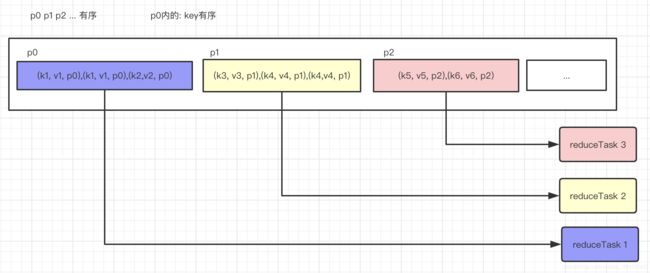
为什么有 combiner
在map阶段进行合并操作,降低后续reduceTask的计算压力;也相当于提前做一次小reduce操作
- 并不是所有的程序都适合combiner
- 需要测试
- 默认关闭的
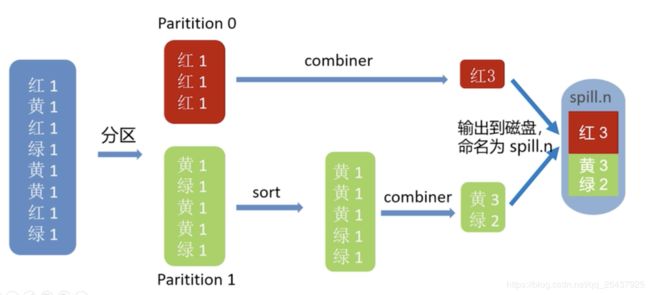
eg: Sum()求和适合,Average()求平均数不适合;例如,求0、20、10、25 、15的平均数,直接使用Reduce求平均数Average(0,20,10,25,15),得到的结果是14, 如果先使用Combiner分别对不同Mapper结果求平均数,Average(0,20,10)=10,Average(25,15)=20,再使用Reducer求平均数Average(10,20),得到的结果为15,很明显求平均数并不适合使用Combiner。
为什么有 compression
减少磁盘IO和网络IO
mapreduce处理流程图
map 到 shuffle 到 reduce 实例流程图
ReduceTask
reduceTask流程
ReduceTask
input -> reduce -> output
map:run: while(context.nextKeyValue())
一条记录调用一次map
reduece:run while(context.nextKey())
一组数据调用一次reduce
shuffle: 拉取数据(相同partion的key会被拉取到一个partion)(一个partition 一个 reduceTask)
sort: 归并排序, grouping comparator
reduce run: 迭代器
reduce拉取属于自己partition的数据,并包装成迭代器
reduce方法被调用的时候,并没有把一组数据真的加载到内存中,而是传递一个迭代器-values
hasNext:判断下一条是否还在当前一组的nextKeyIsSame
next:负责读取nextKeyValue方法,同时也会更新nextKeyIsSame
- Reducer
/**
* Advanced application writers can use the
* {@link #run(org.apache.hadoop.mapreduce.Reducer.Context)} method to
* control how the reduce task works.
*/
public void run(Context context) throws IOException, InterruptedException {
setup(context);
try {
while (context.nextKey()) {
reduce(context.getCurrentKey(), context.getValues(), context);
// If a back up store is used, reset it
Iterator<VALUEIN> iter = context.getValues().iterator();
if(iter instanceof ReduceContext.ValueIterator) {
((ReduceContext.ValueIterator<VALUEIN>)iter).resetBackupStore();
}
}
} finally {
cleanup(context);
}
}
ReduceTask run()
@Override
@SuppressWarnings("unchecked")
public void run(JobConf job, final TaskUmbilicalProtocol umbilical)
throws IOException, InterruptedException, ClassNotFoundException {
job.setBoolean(JobContext.SKIP_RECORDS, isSkipping());
if (isMapOrReduce()) {
copyPhase = getProgress().addPhase("copy");
sortPhase = getProgress().addPhase("sort");
reducePhase = getProgress().addPhase("reduce");
}
// start thread that will handle communication with parent
TaskReporter reporter = startReporter(umbilical);
boolean useNewApi = job.getUseNewReducer();
initialize(job, getJobID(), reporter, useNewApi);
// check if it is a cleanupJobTask
if (jobCleanup) {
runJobCleanupTask(umbilical, reporter);
return;
}
if (jobSetup) {
runJobSetupTask(umbilical, reporter);
return;
}
if (taskCleanup) {
runTaskCleanupTask(umbilical, reporter);
return;
}
// Initialize the codec
codec = initCodec();
RawKeyValueIterator rIter = null;
ShuffleConsumerPlugin shuffleConsumerPlugin = null;
Class combinerClass = conf.getCombinerClass();
CombineOutputCollector combineCollector =
(null != combinerClass) ?
new CombineOutputCollector(reduceCombineOutputCounter, reporter, conf) : null;
Class<? extends ShuffleConsumerPlugin> clazz =
job.getClass(MRConfig.SHUFFLE_CONSUMER_PLUGIN, Shuffle.class, ShuffleConsumerPlugin.class);
shuffleConsumerPlugin = ReflectionUtils.newInstance(clazz, job);
LOG.info("Using ShuffleConsumerPlugin: " + shuffleConsumerPlugin);
ShuffleConsumerPlugin.Context shuffleContext =
new ShuffleConsumerPlugin.Context(getTaskID(), job, FileSystem.getLocal(job), umbilical,
super.lDirAlloc, reporter, codec,
combinerClass, combineCollector,
spilledRecordsCounter, reduceCombineInputCounter,
shuffledMapsCounter,
reduceShuffleBytes, failedShuffleCounter,
mergedMapOutputsCounter,
taskStatus, copyPhase, sortPhase, this,
mapOutputFile, localMapFiles);
shuffleConsumerPlugin.init(shuffleContext);
rIter = shuffleConsumerPlugin.run();
// free up the data structures
mapOutputFilesOnDisk.clear();
sortPhase.complete(); // sort is complete
setPhase(TaskStatus.Phase.REDUCE);
statusUpdate(umbilical);
Class keyClass = job.getMapOutputKeyClass();
Class valueClass = job.getMapOutputValueClass();
RawComparator comparator = job.getOutputValueGroupingComparator();
if (useNewApi) {
runNewReducer(job, umbilical, reporter, rIter, comparator,
keyClass, valueClass);
} else {
runOldReducer(job, umbilical, reporter, rIter, comparator,
keyClass, valueClass);
}
shuffleConsumerPlugin.close();
done(umbilical, reporter);
}
reduce的三个阶段
copyPhase = getProgress().addPhase("copy");
sortPhase = getProgress().addPhase("sort");
reducePhase = getProgress().addPhase("reduce");
- 首先需要从各个mapTask的输出文件下载自身reduceTask要执行的分区部分
- 显然为了减少IO,需要
归并排序进行文件合并,方便reduce任务处理 - reduce操作后写结果回磁盘
reduce的输入来源?(shuffle拉取)
Shuffle run方法
mapreduce.reduce.shuffle.parallelcopies并发线程拉取
@Override
public RawKeyValueIterator run() throws IOException, InterruptedException {
// Scale the maximum events we fetch per RPC call to mitigate OOM issues
// on the ApplicationMaster when a thundering herd of reducers fetch events
// TODO: This should not be necessary after HADOOP-8942
int eventsPerReducer = Math.max(MIN_EVENTS_TO_FETCH,
MAX_RPC_OUTSTANDING_EVENTS / jobConf.getNumReduceTasks());
int maxEventsToFetch = Math.min(MAX_EVENTS_TO_FETCH, eventsPerReducer);
// Start the map-completion events fetcher thread
final EventFetcher<K, V> eventFetcher =
new EventFetcher<K, V>(reduceId, umbilical, scheduler, this,
maxEventsToFetch);
eventFetcher.start();
// Start the map-output fetcher threads
boolean isLocal = localMapFiles != null;
final int numFetchers = isLocal ? 1 :
jobConf.getInt(MRJobConfig.SHUFFLE_PARALLEL_COPIES, 5);
Fetcher<K, V>[] fetchers = new Fetcher[numFetchers];
if (isLocal) {
fetchers[0] = new LocalFetcher<K, V>(jobConf, reduceId, scheduler,
merger, reporter, metrics, this, reduceTask.getShuffleSecret(),
localMapFiles);
fetchers[0].start();
} else {
for (int i=0; i < numFetchers; ++i) {
fetchers[i] = new Fetcher<K, V>(jobConf, reduceId, scheduler, merger,
reporter, metrics, this,
reduceTask.getShuffleSecret());
fetchers[i].start();
}
}
// Wait for shuffle to complete successfully
while (!scheduler.waitUntilDone(PROGRESS_FREQUENCY)) {
reporter.progress();
synchronized (this) {
if (throwable != null) {
throw new ShuffleError("error in shuffle in " + throwingThreadName,
throwable);
}
}
}
// Stop the event-fetcher thread
eventFetcher.shutDown();
// Stop the map-output fetcher threads
for (Fetcher<K, V> fetcher : fetchers) {
fetcher.shutDown();
}
// stop the scheduler
scheduler.close();
copyPhase.complete(); // copy is already complete
taskStatus.setPhase(TaskStatus.Phase.SORT);
reduceTask.statusUpdate(umbilical);
// Finish the on-going merges...
RawKeyValueIterator kvIter = null;
try {
kvIter = merger.close();
} catch (Throwable e) {
throw new ShuffleError("Error while doing final merge ", e);
}
// Sanity check
synchronized (this) {
if (throwable != null) {
throw new ShuffleError("error in shuffle in " + throwingThreadName,
throwable);
}
}
return kvIter;
}
public void run() {
try {
while (!stopped && !Thread.currentThread().isInterrupted()) {
MapHost host = null;
try {
// If merge is on, block
merger.waitForResource();
// Get a host to shuffle from
host = scheduler.getHost();
metrics.threadBusy();
// Shuffle
copyFromHost(host);
} finally {
if (host != null) {
scheduler.freeHost(host);
metrics.threadFree();
}
}
}
} catch (InterruptedException ie) {
return;
} catch (Throwable t) {
exceptionReporter.reportException(t);
}
}
在shuffle 拉取数据完成后,相关拉取线程关闭,然后会返回RawKeyValueIterator,在真正执行reduce操作之前,还会进行一次排序, 这使得一个reduce拉取到的是一个有序的数据集
rIter 迭代器模式的使用?
数据仍在磁盘中,使用迭代器模式,直接文件IO读取,避免大数据量在内存中导致内存不足的问题
runNewReducer
runNewReducer(job, umbilical, reporter, rIter, comparator,
keyClass, valueClass);
reducer对象使用Job设置的reducerClass
@SuppressWarnings("unchecked")
private <INKEY,INVALUE,OUTKEY,OUTVALUE>
void runNewReducer(JobConf job,
final TaskUmbilicalProtocol umbilical,
final TaskReporter reporter,
RawKeyValueIterator rIter,
RawComparator<INKEY> comparator,
Class<INKEY> keyClass,
Class<INVALUE> valueClass
) throws IOException,InterruptedException,
ClassNotFoundException {
// wrap value iterator to report progress.
final RawKeyValueIterator rawIter = rIter;
rIter = new RawKeyValueIterator() {
public void close() throws IOException {
rawIter.close();
}
public DataInputBuffer getKey() throws IOException {
return rawIter.getKey();
}
public Progress getProgress() {
return rawIter.getProgress();
}
public DataInputBuffer getValue() throws IOException {
return rawIter.getValue();
}
public boolean next() throws IOException {
boolean ret = rawIter.next();
reporter.setProgress(rawIter.getProgress().getProgress());
return ret;
}
};
// make a task context so we can get the classes
org.apache.hadoop.mapreduce.TaskAttemptContext taskContext =
new org.apache.hadoop.mapreduce.task.TaskAttemptContextImpl(job,
getTaskID(), reporter);
// make a reducer
org.apache.hadoop.mapreduce.Reducer<INKEY,INVALUE,OUTKEY,OUTVALUE> reducer =
(org.apache.hadoop.mapreduce.Reducer<INKEY,INVALUE,OUTKEY,OUTVALUE>)
ReflectionUtils.newInstance(taskContext.getReducerClass(), job);
org.apache.hadoop.mapreduce.RecordWriter<OUTKEY,OUTVALUE> trackedRW =
new NewTrackingRecordWriter<OUTKEY, OUTVALUE>(this, taskContext);
job.setBoolean("mapred.skip.on", isSkipping());
job.setBoolean(JobContext.SKIP_RECORDS, isSkipping());
org.apache.hadoop.mapreduce.Reducer.Context
reducerContext = createReduceContext(reducer, job, getTaskID(),
rIter, reduceInputKeyCounter,
reduceInputValueCounter,
trackedRW,
committer,
reporter, comparator, keyClass,
valueClass);
try {
reducer.run(reducerContext);
} finally {
trackedRW.close(reducerContext);
}
}
如何执行reduce方法?
也是迭代器模式(不过是两次:nextKey, 然后ValueIterator)
/**
* Advanced application writers can use the
* {@link #run(org.apache.hadoop.mapreduce.Reducer.Context)} method to
* control how the reduce task works.
*/
public void run(Context context) throws IOException, InterruptedException {
setup(context);
try {
while (context.nextKey()) {
reduce(context.getCurrentKey(), context.getValues(), context);
// If a back up store is used, reset it
Iterator<VALUEIN> iter = context.getValues().iterator();
if(iter instanceof ReduceContext.ValueIterator) {
((ReduceContext.ValueIterator<VALUEIN>)iter).resetBackupStore();
}
}
} finally {
cleanup(context);
}
}
reduce的结果是程序员context.write
/**
* This method is called once for each key. Most applications will define
* their reduce class by overriding this method. The default implementation
* is an identity function.
*/
@SuppressWarnings("unchecked")
protected void reduce(KEYIN key, Iterable<VALUEIN> values, Context context
) throws IOException, InterruptedException {
for(VALUEIN value: values) {
context.write((KEYOUT) key, (VALUEOUT) value);
}
}
shuffle

shuffle 包括了map的输出 到 reduce 的数据输入处理
mapreduce log 学习
WordCount 例子
输入 & 输出
hdfs命令
hadoop fs -put ~/words.txt hdfs://localhost:9000/input/wcinput
hadoop fs -ls hdfs://localhost:9000/
hadoop fs -mkdir hdfs://localhost:9000/output
hadoop fs -cat hdfs://localhost:9000/output/wcoutput/part-r-00000
原始input
hello hadoop
hello world hello
hadoop hello
最后的mapreduce输出
hadoop 2
hello 4
world 1
不实用combiner & 使用combiner的log 区别
2020-04-30 00:04:57,430 INFO [org.apache.hadoop.mapreduce.Job] - Counters: 36
File System Counters
FILE: Number of bytes read=524
FILE: Number of bytes written=709206
FILE: Number of read operations=0
FILE: Number of large read operations=0
FILE: Number of write operations=0
HDFS: Number of bytes read=88
HDFS: Number of bytes written=25
HDFS: Number of read operations=15
HDFS: Number of large read operations=0
HDFS: Number of write operations=4
HDFS: Number of bytes read erasure-coded=0
Map-Reduce Framework
Map input records=3
Map output records=7
Map output bytes=72
Map output materialized bytes=92
Input split bytes=100
Combine input records=0
Combine output records=0
Reduce input groups=3
Reduce shuffle bytes=92
Reduce input records=7
Reduce output records=3
Spilled Records=14
Shuffled Maps =1
Failed Shuffles=0
Merged Map outputs=1
GC time elapsed (ms)=7
Total committed heap usage (bytes)=586153984
Shuffle Errors
BAD_ID=0
CONNECTION=0
IO_ERROR=0
WRONG_LENGTH=0
WRONG_MAP=0
WRONG_REDUCE=0
File Input Format Counters
Bytes Read=44
File Output Format Counters
Bytes Written=25
2020-04-30 00:04:57,430 DEBUG [org.apache.hadoop.security.UserGroupInformation] - PrivilegedAction as:mubi (auth:SIMPLE) from:org.apache.hadoop.mapreduce.Job.updateStatus(Job.java:328)
- Map output records=7 即是 Reduce input records=7
// 第一行
hello 1
hadoop 1
// 第二行
hello 1
world 1
hello 1
// 第三行
hadoop 1
hello 1
- 加入combiner
job.setCombinerClass(WordCountReducer.class);
2020-04-30 00:22:10,512 INFO [org.apache.hadoop.mapreduce.Job] - Counters: 36
File System Counters
FILE: Number of bytes read=426
FILE: Number of bytes written=709865
FILE: Number of read operations=0
FILE: Number of large read operations=0
FILE: Number of write operations=0
HDFS: Number of bytes read=88
HDFS: Number of bytes written=25
HDFS: Number of read operations=17
HDFS: Number of large read operations=0
HDFS: Number of write operations=6
HDFS: Number of bytes read erasure-coded=0
Map-Reduce Framework
Map input records=3
Map output records=7
Map output bytes=72
Map output materialized bytes=43
Input split bytes=100
Combine input records=7
Combine output records=3
Reduce input groups=3
Reduce shuffle bytes=43
Reduce input records=3
Reduce output records=3
Spilled Records=6
Shuffled Maps =1
Failed Shuffles=0
Merged Map outputs=1
GC time elapsed (ms)=79
Total committed heap usage (bytes)=801112064
Shuffle Errors
BAD_ID=0
CONNECTION=0
IO_ERROR=0
WRONG_LENGTH=0
WRONG_MAP=0
WRONG_REDUCE=0
File Input Format Counters
Bytes Read=44
File Output Format Counters
Bytes Written=25
2020-04-30 00:22:10,512 DEBUG [org.apache.hadoop.security.UserGroupInformation] - PrivilegedAction as:mubi (auth:SIMPLE) from:org.apache.hadoop.mapreduce.Job.updateStatus(Job.java:328)
多了combine, 且reduce的输入是combine 的输出了
Combine input records=7
Combine output records=3
Reduce input groups=3
Reduce shuffle bytes=43
Reduce input records=3
Reduce output records=3
自定义key排序:job.setSortComparatorClass
word count, 让 word 逆序
static class KeyComparator extends WritableComparator{
public KeyComparator() {
super(Text.class, true);
}
@Override
public int compare(WritableComparable w1, WritableComparable w2) {
Text key1 = (Text)w1;
Text key2 = (Text)w2;
String s1 = key1.toString();
String s2 = key2.toString();
return s2.compareTo(s1);
}
}
然后程序设置
// 设置key排序
job.setSortComparatorClass(KeyComparator.class);
最后结果输出
world 1
hello 4
hadoop 2
word count java 程序
import java.io.IOException;
import java.net.URI;
import java.util.Iterator;
import org.apache.hadoop.conf.Configuration;
import org.apache.hadoop.fs.FileSystem;
import org.apache.hadoop.fs.Path;
import org.apache.hadoop.io.IntWritable;
import org.apache.hadoop.io.LongWritable;
import org.apache.hadoop.io.Text;
import org.apache.hadoop.mapreduce.Job;
import org.apache.hadoop.mapreduce.Mapper;
import org.apache.hadoop.mapreduce.Reducer;
import org.apache.hadoop.mapreduce.lib.input.FileInputFormat;
import org.apache.hadoop.mapreduce.lib.output.FileOutputFormat;
/**
* @Author mubi
* @Date 2020/4/28 23:39
*/
public class WC {
/**
* map函数
*
* 四个泛型类型分别代表:
* KeyIn Mapper的输入数据的Key,这里是每行文字的起始位置(0,11,...)
* ValueIn Mapper的输入数据的Value,这里是每行文字
* KeyOut Mapper的输出数据的Key,这里是每行文字中的"单词"
* ValueOut Mapper的输出数据的Value,这里是单词的数量"1"
*/
static class WordCountMapper extends
Mapper<LongWritable, Text, Text, IntWritable> {
@Override
public void map(LongWritable key, Text value, Mapper<LongWritable, Text, Text, IntWritable>.Context context)
throws IOException, InterruptedException {
// 将mapTask传给我们的文本内容先转换为String
String line = value.toString();
// 根据空格将这一行切分为单词
String[] words = line.split(" ");
// 将单词输出为<单词,1>
for(String word: words){
// 将单词作为key, 将次数作为value, 以便于后续的数据分发, 根据单词分发, 以便于相同单词会到相同的reduceTask内部.
context.write(new Text(word), new IntWritable(1));
}
}
}
/**
* reduce函数
*
* 四个泛型类型分别代表:
* KeyIn Reducer的输入数据的Key,这里是每行文字中的“单词”
* ValueIn Reducer的输入数据的Value,这里是单词数量列表
* KeyOut Reducer的输出数据的Key,这里是不重复的“单词”
* ValueOut Reducer的输出数据的Value,这里是单词总数量
*/
static class WordCountReducer extends
Reducer<Text, IntWritable, Text, IntWritable> {
@Override
protected void reduce(Text key, Iterable<IntWritable> values, Reducer<Text, IntWritable, Text, IntWritable>.Context context)throws IOException, InterruptedException {
int count=0;
Iterator<IntWritable> it = values.iterator();
while(it.hasNext()){
count += it.next().get();
}
context.write(key, new IntWritable(count));
}
}
public static void main(String[] args) throws Exception {
//输入路径
String dst = "hdfs://localhost:9000/input/wcinput";
// String dst = "hdfs://localhost:9000" + args[1];
//输出路径,必须是不存在的,空文件也不行。
String dstOut = "hdfs://localhost:9000/output/wcoutput";
// String dstOut = "hdfs://localhost:9000" + args[2];
Configuration hadoopConfig = new Configuration();
hadoopConfig.set("fs.hdfs.impl",
org.apache.hadoop.hdfs.DistributedFileSystem.class.getName()
);
hadoopConfig.set("fs.file.impl",
org.apache.hadoop.fs.LocalFileSystem.class.getName()
);
//如果输出目录已经存在,则先删除
FileSystem fileSystem = FileSystem.get(new URI("hdfs://localhost:9000"), hadoopConfig);
Path outputPath = new Path("/output/wcoutput");
if(fileSystem.exists(outputPath)){
fileSystem.delete(outputPath,true);
}
//如果输出目录已经存在,则先删除
FileSystem fileSystem = FileSystem.get(new URI("hdfs://localhost:9000"), hadoopConfig);
Path outputPath = new Path("/output/wcoutput");
if(fileSystem.exists(outputPath)){
fileSystem.delete(outputPath,true);
}
Job job = new Job(hadoopConfig);
//如果需要打成jar运行,需要下面这句
job.setJarByClass(WC.class);
job.setJobName("wordcount");
//job执行作业时输入和输出文件的路径
FileInputFormat.addInputPath(job, new Path(dst));
FileOutputFormat.setOutputPath(job, new Path(dstOut));
//指定自定义的Mapper和Reducer作为两个阶段的任务处理类
job.setMapperClass(WordCountMapper.class);
job.setReducerClass(WordCountReducer.class);
// 设置combiner
job.setCombinerClass(WordCountReducer.class);
//设置最后输出结果的Key和Value的类型
job.setOutputKeyClass(Text.class);
job.setOutputValueClass(IntWritable.class);
//执行job,直到完成
job.waitForCompletion(true);
System.out.println("Job Finished");
System.exit(0);
}
}
- 依赖
<dependencies>
<!-- https://mvnrepository.com/artifact/org.apache.hadoop/hadoop-client -->
<dependency>
<groupId>org.apache.hadoop</groupId>
<artifactId>hadoop-client</artifactId>
<version>3.2.1</version>
</dependency>
<!-- https://mvnrepository.com/artifact/org.apache.hadoop/hadoop-common -->
<dependency>
<groupId>org.apache.hadoop</groupId>
<artifactId>hadoop-common</artifactId>
<version>3.2.1</version>
</dependency>
<!-- https://mvnrepository.com/artifact/org.apache.hadoop/hadoop-mapreduce-client-jobclient -->
<dependency>
<groupId>org.apache.hadoop</groupId>
<artifactId>hadoop-mapreduce-client-jobclient</artifactId>
<version>3.2.1</version>
<scope>provided</scope>
</dependency>
<!-- https://mvnrepository.com/artifact/org.apache.hadoop/hadoop-mapreduce-client-common -->
<dependency>
<groupId>org.apache.hadoop</groupId>
<artifactId>hadoop-mapreduce-client-common</artifactId>
<version>3.2.1</version>
</dependency>
</dependencies>
- gradle 格式
// https://mvnrepository.com/artifact/org.apache.hadoop/hadoop-client
compile group: 'org.apache.hadoop', name: 'hadoop-client', version: '3.2.1'
// https://mvnrepository.com/artifact/org.apache.hadoop/hadoop-common
compile group: 'org.apache.hadoop', name: 'hadoop-common', version: '3.2.1'
// https://mvnrepository.com/artifact/org.apache.hadoop/hadoop-mapreduce-client-jobclient
compile group: 'org.apache.hadoop', name: 'hadoop-mapreduce-client-jobclient', version: '3.2.1'
